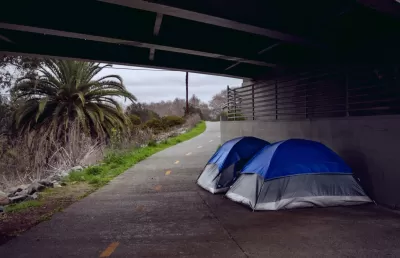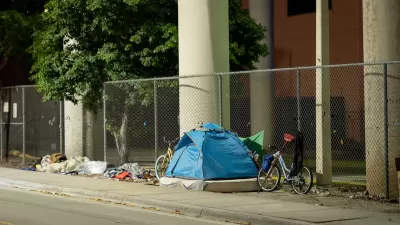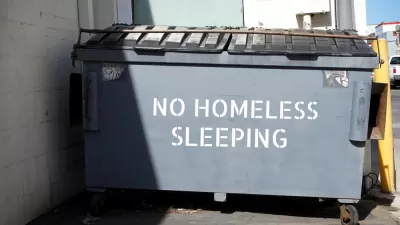An ordinance supported by the city’s mayor would bar people from sleeping on the street near shelters or services, but critics say it will simply push people to other neighborhoods and put them farther away from the supportive services they need.

A proposed San Diego city ordinance would “would bar camping on public property when shelter is available and within two blocks of shelters and schools, parks, open spaces and along waterways and transit hubs even when it’s not,” reports Lisa Halverstadt for Voice of San Diego.
According to the article, unhoused residents wouldn’t be allowed to set up tents near shelters and service providers even when there are no open beds available to them, which some residents worry will lead to an increase in people moving to other areas that lack any public services and cause people to lose contact with service providers. Halverstadt points out, “A lack of bed availability has for years hampered enforcement efforts – even as the city has opened hundreds of additional beds on [Mayor Todd Gloria]’s watch.” The city is banned by a 2018 court ruling from issuing citations for sidewalk sleeping when no shelter is available.
“Whitburn and Gloria argue that hundreds of unsheltered residents will be offered spaces at two new safe campgrounds that could collectively accommodate 500 tents and that there are plans to add more shelter beds too.” Unhoused residents expressed concern about the size and rules of the city-planned campsites.
California, which is home to roughly one-third of unhoused people in the United States, is one of the first recipients of funding from the federal ‘ALL INside’ initiative, which will offer assistance and support to states and cities for programs to address the homelessness crisis.
FULL STORY: What a Crackdown on Homeless Camps Could Mean for Neighborhoods

Alabama: Trump Terminates Settlements for Black Communities Harmed By Raw Sewage
Trump deemed the landmark civil rights agreement “illegal DEI and environmental justice policy.”

Planetizen Federal Action Tracker
A weekly monitor of how Trump’s orders and actions are impacting planners and planning in America.

The 120 Year Old Tiny Home Villages That Sheltered San Francisco’s Earthquake Refugees
More than a century ago, San Francisco mobilized to house thousands of residents displaced by the 1906 earthquake. Could their strategy offer a model for the present?

In Both Crashes and Crime, Public Transportation is Far Safer than Driving
Contrary to popular assumptions, public transportation has far lower crash and crime rates than automobile travel. For safer communities, improve and encourage transit travel.

Report: Zoning Reforms Should Complement Nashville’s Ambitious Transit Plan
Without reform, restrictive zoning codes will limit the impact of the city’s planned transit expansion and could exclude some of the residents who depend on transit the most.

Judge Orders Release of Frozen IRA, IIJA Funding
The decision is a victory for environmental groups who charged that freezing funds for critical infrastructure and disaster response programs caused “real and irreparable harm” to communities.
Urban Design for Planners 1: Software Tools
This six-course series explores essential urban design concepts using open source software and equips planners with the tools they need to participate fully in the urban design process.
Planning for Universal Design
Learn the tools for implementing Universal Design in planning regulations.
Clanton & Associates, Inc.
Jessamine County Fiscal Court
Institute for Housing and Urban Development Studies (IHS)
City of Grandview
Harvard GSD Executive Education
Toledo-Lucas County Plan Commissions
Salt Lake City
NYU Wagner Graduate School of Public Service





























